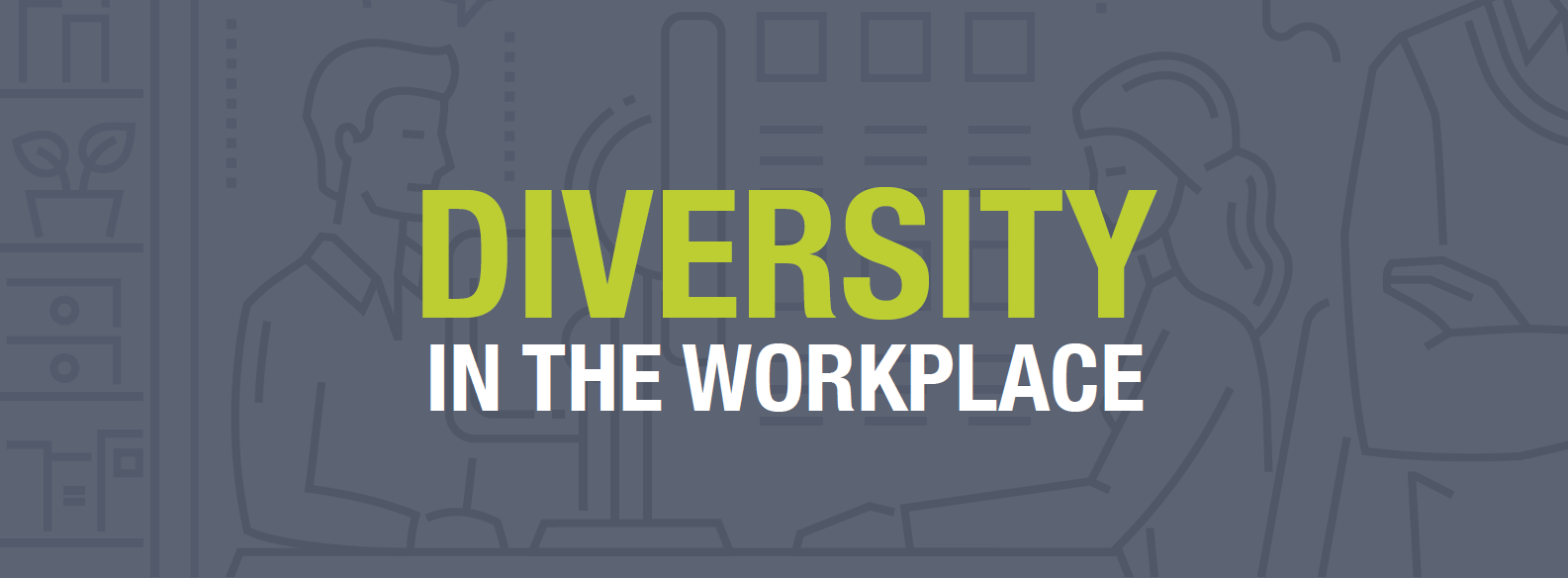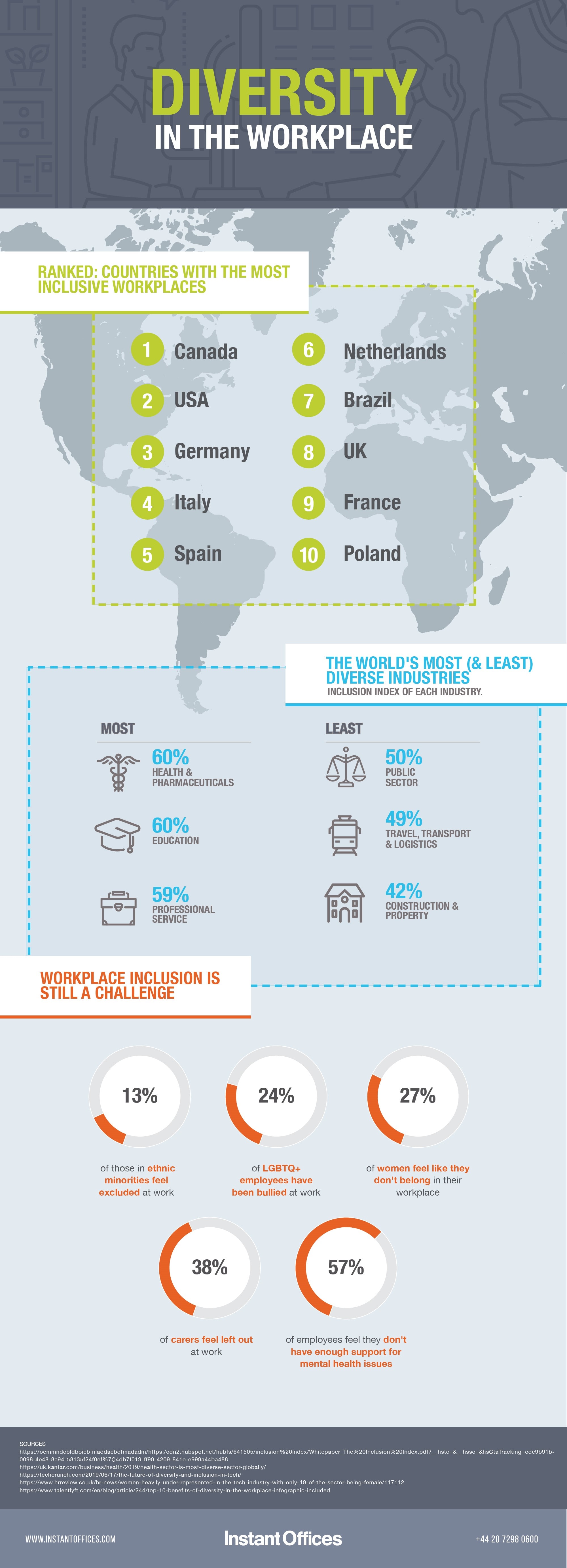Gender equality in the workplace has come a long way, but did you know that 27% of women still report being made to feel like they don’t belong in their workplace? That’s more than a quarter of today’s female workforce. Employees who are part of an ethnic minority are also facing daily struggles, with 13% feeling excluded at work and 11% saying they are treated differently in the workplace due to their ethnicity. How do we drive real positive change around inclusion and diversity in the workplace in the face of such a widespread issue?
According to the ONS, these are the top three ethnic groups employed in each occupation in the UK:
Manager, Director and Senior Official Roles
32% – white, British white and white other (which includes Western or Eastern Europeans, Australians etc)
11% – Indian
10% Asian
The Professional Sector
61% – white, British white and ‘white other’
33% – Indian
29% – Asian other
Elementary – the lowest skilled type of occupation
16% – Black
15% – White other
15% – Pakistani and Bangladeshi
Global Diversity in the Workplace
The recently released Kantar Inclusion Index highlights the diversity (or lack thereof) across geographic locations and industries. This first-of-its-kind index was based on the feedback of 18,000 employees across 14 countries and 24 different industries. These countries have the most diverse workplaces worldwide:
| Country | Inclusion Index |
|---|---|
| Canada | 66% |
| USA | 66% |
| Germany | 65% |
| Italy | 62% |
| Spain | 60% |
| Netherlands | 60% |
| Brazil | 60% |
| UK | 56% |
| France | 55% |
| Poland | 53% |
Lucinda Pullinger, Global Head of HR for The Instant Group, says, “it’s important to remember that a diverse workforce and an inclusive culture are different. If you have diversity, you don’t necessarily have inclusion. There is the argument that inclusion should be a key focus before diversity, otherwise you run the risk of creating a diverse organisation in which the diversity isn’t valued or harnessed due to a lack of inclusion.”
65% of Canadian employees believe that their employers are actively trying to be more diverse and inclusive, and 63% of Americans feel the same.
Meanwhile, the UK is lagging behind a number of its European counterparts, which tend to have more progressive leave policies and a more flexible approach to work overall.
Equality and Diversity Across Industries
The Health and Pharmaceutical industry has been shown to have the most balanced gender representation at a senior level. The tech industry lags far behind, with an Inclusion Index hovering at just over half that of Health and Pharma. Does the long-held stereotype of tech being disproportionately dominated by white male employees still hold true today?
| Industry | Inclusion Index |
|---|---|
| Health & Pharma | 60% |
| Education | 60% |
| Professional Services | 59% |
| Retail, Wholesale & eCommerce | 58% |
| Financial Services | 53% |
| Public Sector | 50% |
| Travel, Transport & Logistics | 49% |
| Construction & Property | 42% |
| Manufacturing | 38% |
| Technology & Telecommunications | 35% |
The Future of Diversity in Tech
In 2014, Google released the tech industry’s first diversity report, revealing that the company at the time was made up of 61.3% white and 69.4% male employees. Today, Google is 54.4% white and 68.4% male, showing that little progress has been made by the search giant in the past five years.
Overall, the major tech industries of Silicon Valley are largely dominated by white and Asian employees, with very little representation of black, Latinx and other ethnicities. Women make up just 19% of the tech sector and just 12.6% of those in senior positions. It’s no surprise that over 70% of tech employers experienced skills shortages in the past year – confirmation that lack of diversity leads to a lack of skills and development within a work environment.
In the UK, tech employees are five times more stressed than the average UK worker, with 14% of people saying their ethnicity has negatively impacted their career progression. In addition, 31% of Asian and South East Asian and 40% of Afro-Caribbean employees in tech have experienced discrimination because of their ethnicity. Within the UK tech industry, 78% of people are under 45 years old, 69% are white and 88% are heterosexual.
Things are slowly beginning to shift, although there is a long way to go. In the past 5 years, social media juggernaut Facebook has increased their number of black female employees by 25 times and black male employees by 10 times. Initiatives like Project Include are also appealing to tech start-ups to improve their diversity for “better teams, better financial returns, better companies, and a better, more innovative world”.
Employees Speak Out About Inclusion in the Workplace
The Inclusion Index also revealed some interesting insights into the ways that age, sexual orientation and health concerns are affecting individuals at work.
• Age: 25% of employees feel that age can limit their chances of progressing at their company.
• Sexual orientation: 24% of LGBTQ+ employees have been bullied at work in the past year, and 36% say their career progression has been hindered because of their orientation.
• Mental health: There is still a widespread stigma around mental health problems and neurodiversity in the workplace. More than half (57%) of employees feel that there is not enough support available to them.
• Caregiving: 38% of carers – those with special care responsibilities for spouses or ageing parents – say they feel left out at work.
Lucinda says, “for things to improve, the focus on diversity in organisations needs to be ongoing and measured. It’s also really important for companies to be transparent about their commitment to diversity to attract and retain the right talent. Examining company policies around equal pay, competitive maternity leave and flexible hours is a good place to start.”
Benefits of Diversity and Inclusion
Companies that know how to promote equality and diversity at work have a significant competitive advantage:
• Higher levels of employee engagement
• Higher levels of innovation and creativity
• Better decision-making and problem-solving
• Increased profits
• Lower staff turnover
• Better company reputation
Diverse workplaces enjoy a wider variety of skills, experiences and perspectives, which all contribute to a more successful way of doing business. It also enables companies to relate to their wider customer base easier, which is especially important in B2C environments. As more reports and surveys continue to shed light on where diversity is lacking, employers are encouraged to embrace the push for a fully diverse workforce and help the business world to become a more progressive place.
Looking for Office Space?
We Operate in Some of the World’s Top Cities:
London, New York, San Francisco, Paris, Singapore, Hong Kong,
Search more locations

